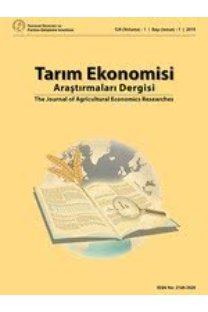Suudi Arabistan Krallığında İthal Meyvelerin Talep Esnekliği
Mevcut araştırma, otuz sekiz yıllık (1979-2017) bir dönem için yayılan zaman serisi verilerini kullanarak Suudi Arabistan Krallığı'ndaki ithal meyvelere olan talebi tahmin etmektedir. Veriler FAO ve UNCTAD veri tabanlarından elde edilmiş olup elma, muz, üzüm, portakal, ananas ve çilek için ithalat miktar ve değerlerini kapsamaktadır. Toplanan veriler, tanımlayıcı istatistikler ve Lineer Yaklaşık İdeal Talep Sistemi (LA / AIDS) modeli kullanılarak analiz edilmiştir. Elde edilen bulgulara göre ortalama bütçe payının elmada, marjinal bütçe payının ise portakalda en yüksek olduğu görülmüştür. Ampirik kanıtlar, elma, muz ve üzümün normal mallar olduğunu, portakal, ananas ve çileğin ise lüks mallar olduğunu göstermiştir. Ayrıca, telafi edilmemiş çapraz fiyat esnekliklerinin telafi edilmiş çapraz fiyat esneklikleri üzerindeki yüksek değerlerinden de anlaşılacağı üzere, gelir etkisinin ithal meyvelere olan talebi etkilemede fiyattan daha güçlü bir etki yarattığı tespit edilmiştir. Bu nedenle çalışma, ülkenin bu meyveleri, özellikle de gerekli olanları, dövizini en üst düzeye çıkarmak ve turizm nüfusu akışından yararlanmak için yoğun yerel üretime başlaması gerektiğini önermektedir. Böylelikle ülke ekonomisi, meyve ihraç eden pazarlardan gelen noksanlıkların bir sonucu olarak ortaya çıkabilecek her türlü pazarlama şokunu absorbe edebilecektir.
Anahtar Kelimeler:
Talep, İthal meyveler, LA/AIDS, Suudi Arabistan
Demand Elasticity of Imported Fruits in the Kingdom of Saudi Arabia
The present research estimated the demand for imported fruits in the Kingdom of Saudi Arabia using time series data that spanned for a period of thirty-eight years (1979-2017). The data were sourced from the FAO and UNCTAD databases and they covered import quantities and values for apple, banana, grape, orange, pineapple and straw berry. The collected data were analyzed using descriptive statistics and Linear Approximate Almost Ideal Demand System (LA/AIDS) model. Based on the findings it was observed that apple has the highest average budget share while orange has the highest marginal budget share. The empirical evidence showed that all the fruit commodities are normal goods with apple, banana and grape been necessities while orange, pineapple and straw berry were luxuries. Furthermore, it was established that income effect waxed stronger effect than price in influencing demand for imported fruit commodities as evidenced from the high values of uncompensated cross-price elasticities over the compensated cross-price elasticities. Therefore, the study recommends that the country should embark on intensive local production of these fruit commodities especially the necessary ones so as to maximize their foreign exchange and take advantage of tourism population influx. By so doing the economy of the nation will be able to absorb any marketing shocks which might arise as a result of market imperfection from fruit exporting markets.
Keywords:
Demand, Imported fruits, LA/AIDS, Saudi Arabia,
___
- Adam, E.A., Azharia, A.E., and Osama, A.S. (2019). Food consumption patterns and trends in Gulf Cooperation Council. Pakistan Journal of Nutrition, 18(7), 623-636.
- Anwarul-Huq, A.S.M., Alam, S. and Sabur, S.A. (2004). Estimation of potato demand elasticities in Bangladesh. Bangladesh Journal of Agricultural Economics, XXVII (1), 1-13.
- Awal, M.A., Sabur, S.A. and Mia, M.I.A (2008). Estimation of vegetable demand elasticities in Bangladesh: Application of almost ideal demand system model. Bangladesh Journal of Agricultural Economics, XXXI(1), 35-60.
- Babar, A., Khalil, M., Zahid, I. and Ijaz, H. (2011). Estimating food demand elasticities in Pakistan: An application of almost ideal demand system. Forman Journal of Economic Studies, 7, 1-24.
- Blanciforti, L. and Green, R. (1983). An almost ideal demand system incorporating habits: An analysis of expenditure on food and aggregate commodity groups. Review of Economic and Statistics, 65(3), 511-15. https://doi.org/10.2307/1924200.
- Clement, K.W. and Si, J. (2015). Price elasticities of food demand: compensated vs. uncompensated. Unpublished Manual, Business School, University of Western Australia. Pp. 5
- EDM. (2016). Saudi Arabia: the biggest consumer in the region. Euro-fresh Distribution Magazine, Vol. 143. https://www.eurofresh-distribution.com/news/saudi-arabia-biggest-consumer-region
- FAO. (2017). Food balance sheet. A Report of Food and Agriculture Organization of the United Nations, Rome.
- FAO. (2019). Supply utilization accounts and food balance sheets-background information for your better understanding. A Report of Food and Agriculture Organization, United Nation, Rome.
- Gheblawi, M. S., Alashry, M.K., Sherif, S., Basarirand, and Ul- Haq, Z. (2013). Analyzing UAE’s imports of fresh fruits utilizing an Almost Ideal Demand System. Bulgarian Journal of Agricultural Science, 19(4), 792-800.
- Jha, R. and Sharma, A.(2001).Structural breaks and unit roots: afurther test of the sustainability of the Indian fiscal deficit. ASARC Working Papers, Australia South Asia Research Center, Australian National University, Canberra
- Sadiq, M.S., Singh, I.P. and Karunakaran, N. (2017). Supply response of cereal crop farmers to price and non-price factors in Rajasthan state of Nigeria. Journal of Agricultural Economics and Rural Development, 3(2), 203-210
- Talijaard, R.R., Alemu, A.G. and Scalkwyk, V.H.D. (2003). A Linearized Almost Ideal Demand System (AL/AIDS). Estimation of demand for meat in South Africa (AEASA), October 2-3, 2003, Pretoria, South Africa.
- Yayın Aralığı: Yılda 2 Sayı
- Başlangıç: 2015
- Yayıncı: Tarımsal Ekonomi ve Politika Geliştirme Enstitüsü Müdürlüğü
Sayıdaki Diğer Makaleler
Suudi Arabistan Krallığında İthal Meyvelerin Talep Esnekliği
Mohammed Sanusi SADIQ, Invinder Paul SINGH, Muhammad Makarfi AHMAD
Orta Asya Ülkelerinde Buğday Üretiminin Ekonomik Gelişim Seyri
Nijerya’da Kasava Üretim Göstergelerinin ARIMA Modeli ile Tahmini ve Gelecek Gıda Arzına Etkisi
Edamisan Stephen IKUEMONISAN, Adeyose Emmanuel AKINBOLA
ARIMA Modeli ile Türkiye Bal Üretim Öngörüsü
Kastamonu İli Merkez İlçesinde Gıda Ürünleri Tercihinde Coğrafi İşaretlerin Etkisi
Mustafa KAN, Arzu KAN, Şevket KÜTÜKOĞLU
“Sürü Yönetimi Elemanı Benim” Projesi Kapsamındaki Tarımsal Eğitim Faaliyetlerinin Analizi
